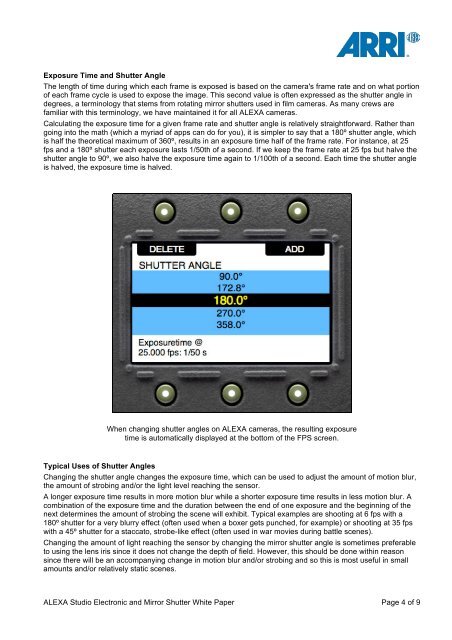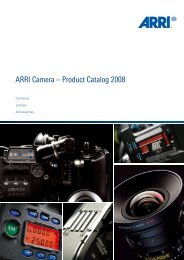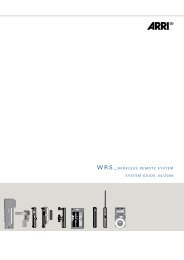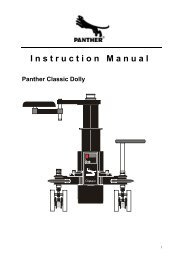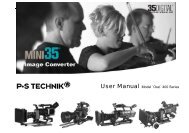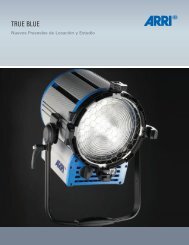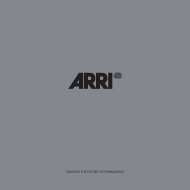ALEXA Studio Electronic and Mirror Shutter
ALEXA Studio Electronic and Mirror Shutter
ALEXA Studio Electronic and Mirror Shutter
You also want an ePaper? Increase the reach of your titles
YUMPU automatically turns print PDFs into web optimized ePapers that Google loves.
Exposure Time <strong>and</strong> <strong>Shutter</strong> Angle<br />
The length of time during which each frame is exposed is based on the camera's frame rate <strong>and</strong> on what portion<br />
of each frame cycle is used to expose the image. This second value is often expressed as the shutter angle in<br />
degrees, a terminology that stems from rotating mirror shutters used in film cameras. As many crews are<br />
familiar with this terminology, we have maintained it for all <strong>ALEXA</strong> cameras.<br />
Calculating the exposure time for a given frame rate <strong>and</strong> shutter angle is relatively straightforward. Rather than<br />
going into the math (which a myriad of apps can do for you), it is simpler to say that a 180º shutter angle, which<br />
is half the theoretical maximum of 360º, results in an exposure time half of the frame rate. For instance, at 25<br />
fps <strong>and</strong> a 180º shutter each exposure lasts 1/50th of a second. If we keep the frame rate at 25 fps but halve the<br />
shutter angle to 90º, we also halve the exposure time again to 1/100th of a second. Each time the shutter angle<br />
is halved, the exposure time is halved.<br />
Typical Uses of <strong>Shutter</strong> Angles<br />
When changing shutter angles on <strong>ALEXA</strong> cameras, the resulting exposure<br />
time is automatically displayed at the bottom of the FPS screen.<br />
Changing the shutter angle changes the exposure time, which can be used to adjust the amount of motion blur,<br />
the amount of strobing <strong>and</strong>/or the light level reaching the sensor.<br />
A longer exposure time results in more motion blur while a shorter exposure time results in less motion blur. A<br />
combination of the exposure time <strong>and</strong> the duration between the end of one exposure <strong>and</strong> the beginning of the<br />
next determines the amount of strobing the scene will exhibit. Typical examples are shooting at 6 fps with a<br />
180º shutter for a very blurry effect (often used when a boxer gets punched, for example) or shooting at 35 fps<br />
with a 45º shutter for a staccato, strobe-like effect (often used in war movies during battle scenes).<br />
Changing the amount of light reaching the sensor by changing the mirror shutter angle is sometimes preferable<br />
to using the lens iris since it does not change the depth of field. However, this should be done within reason<br />
since there will be an accompanying change in motion blur <strong>and</strong>/or strobing <strong>and</strong> so this is most useful in small<br />
amounts <strong>and</strong>/or relatively static scenes.<br />
<strong>ALEXA</strong> <strong>Studio</strong> <strong>Electronic</strong> <strong>and</strong> <strong>Mirror</strong> <strong>Shutter</strong> White Paper Page 4 of 9


